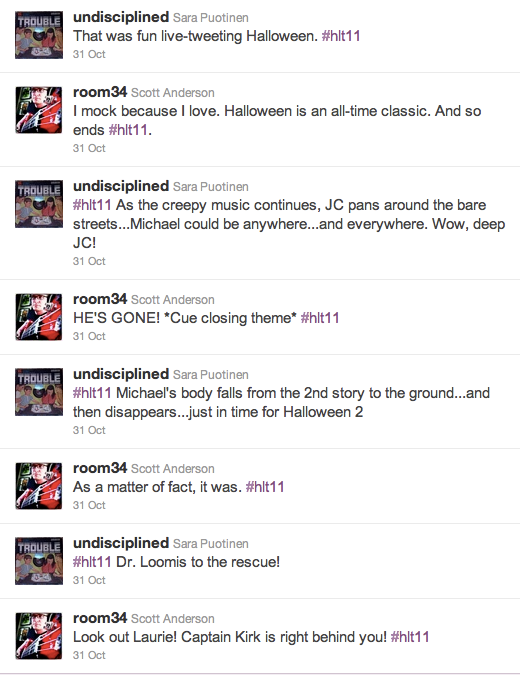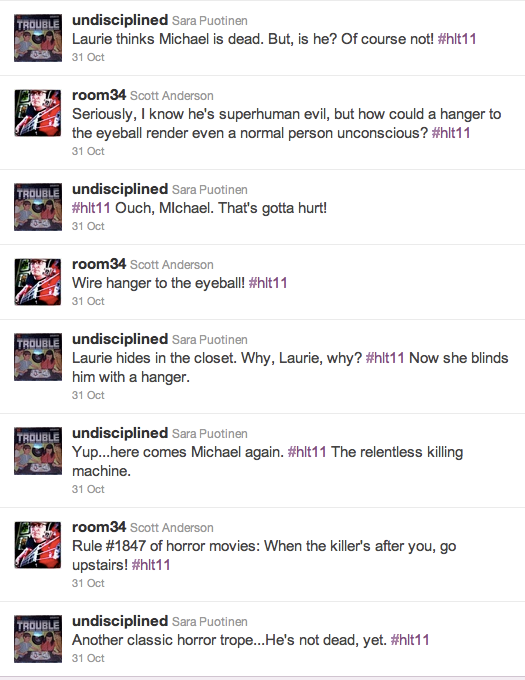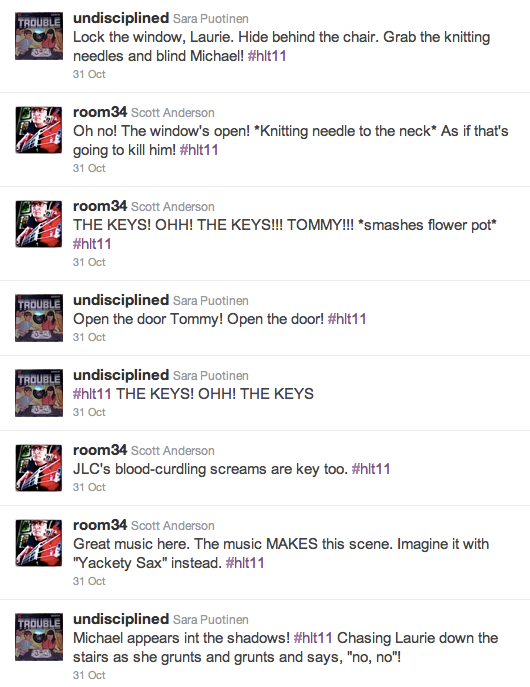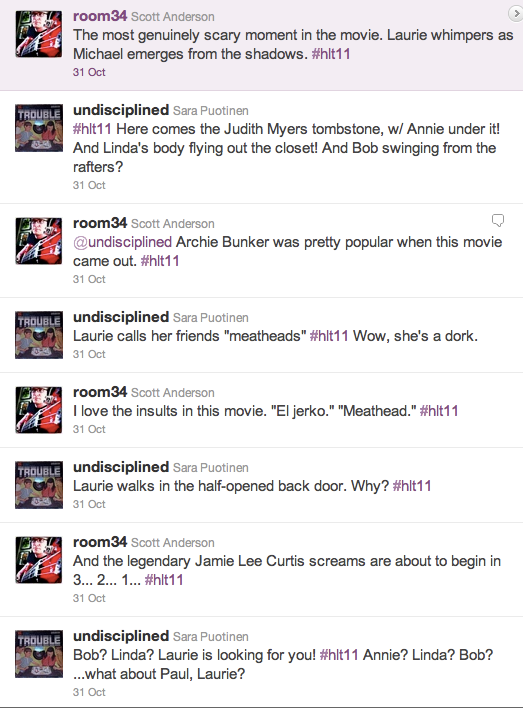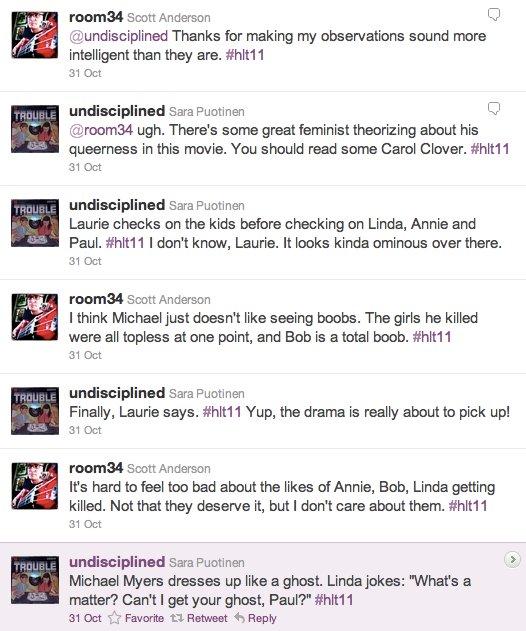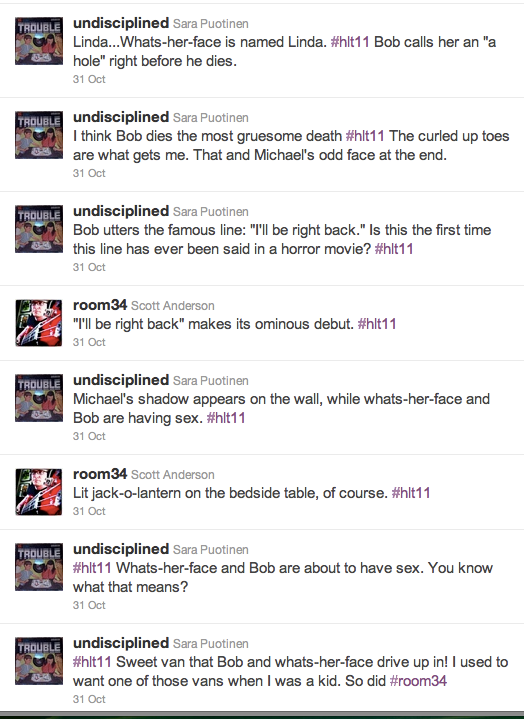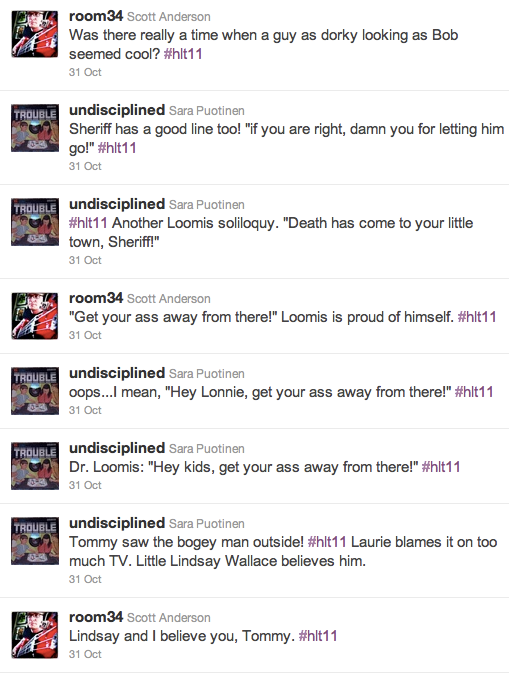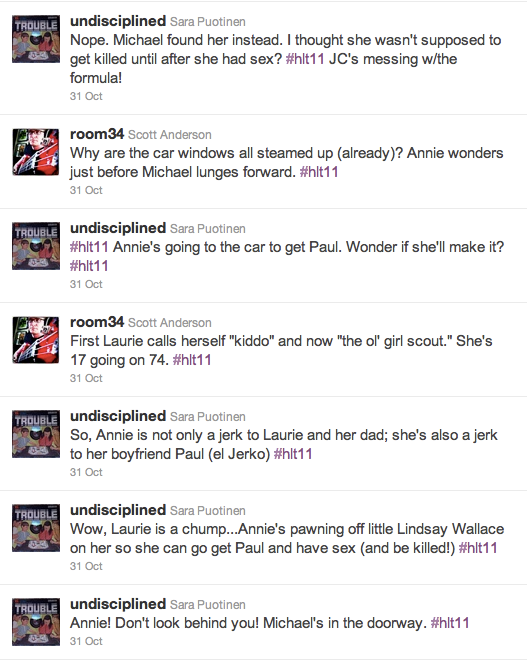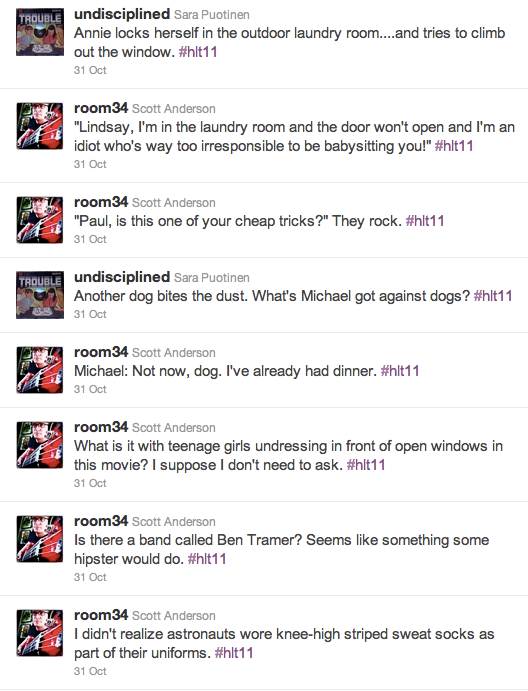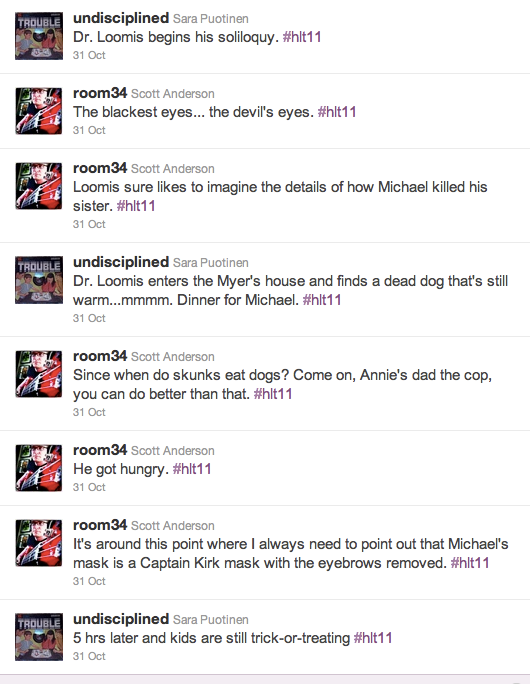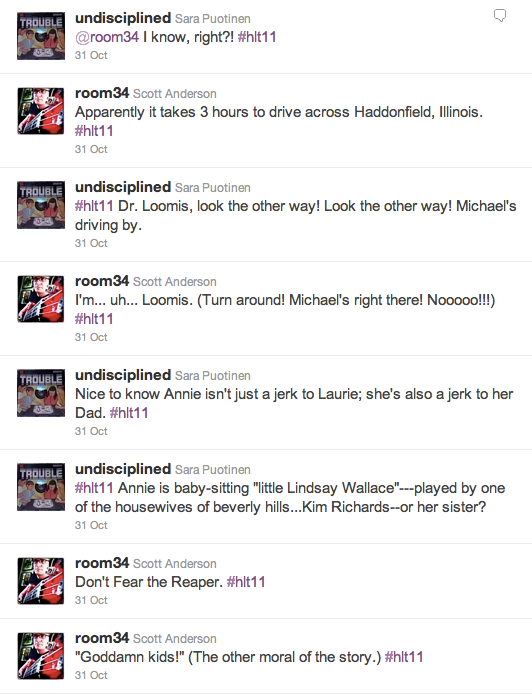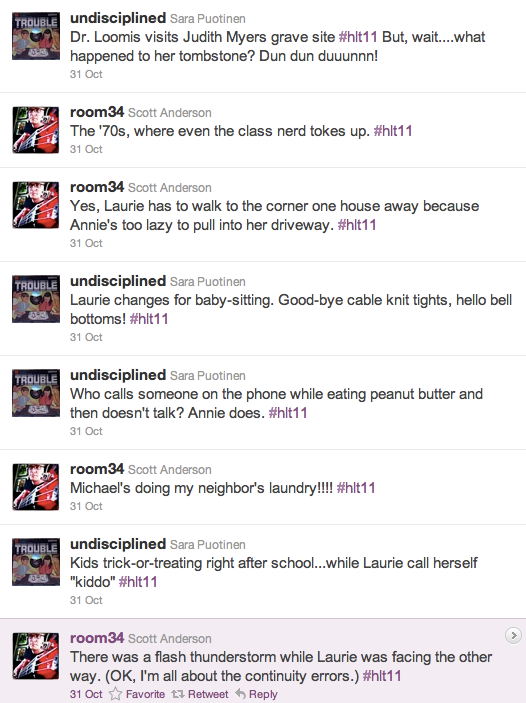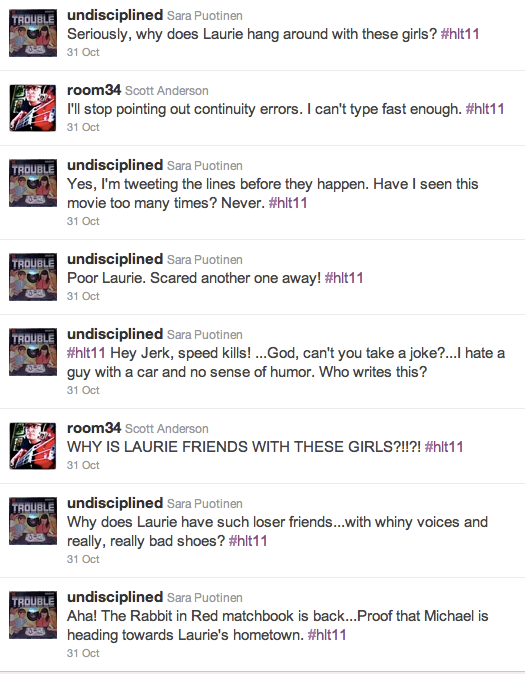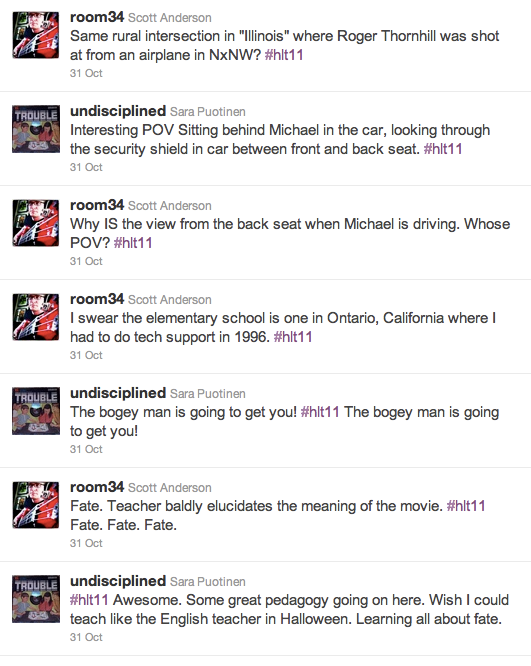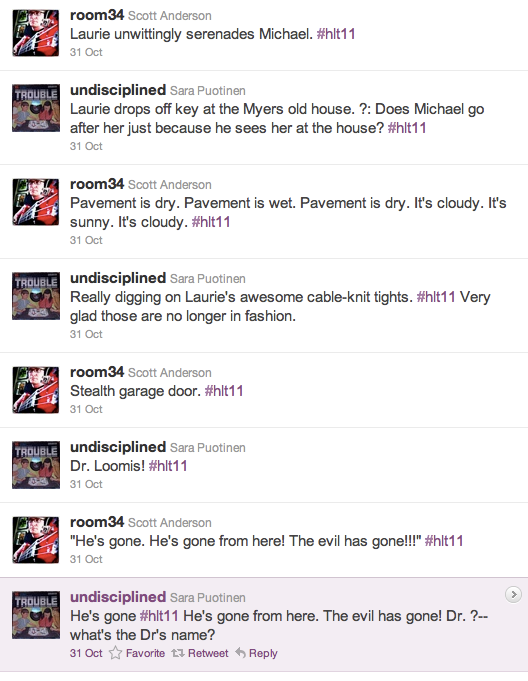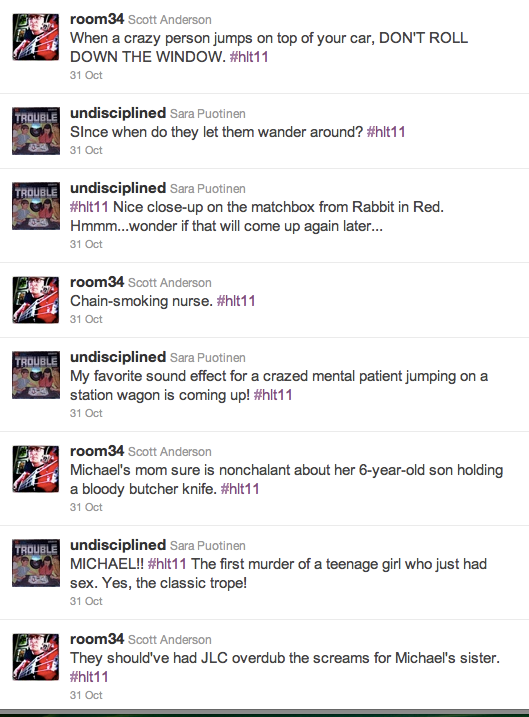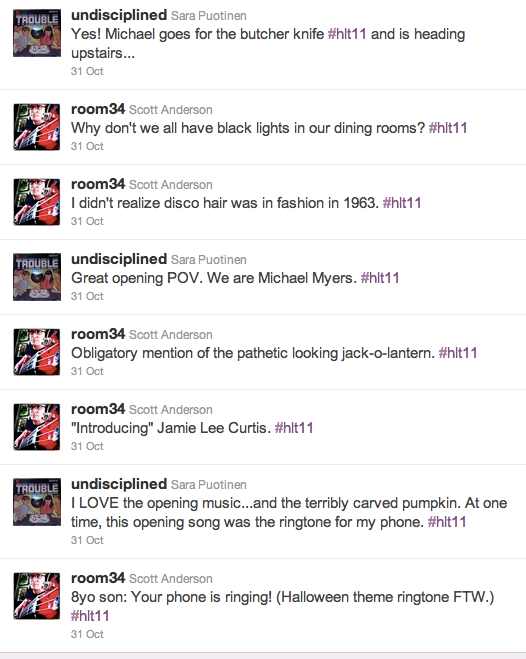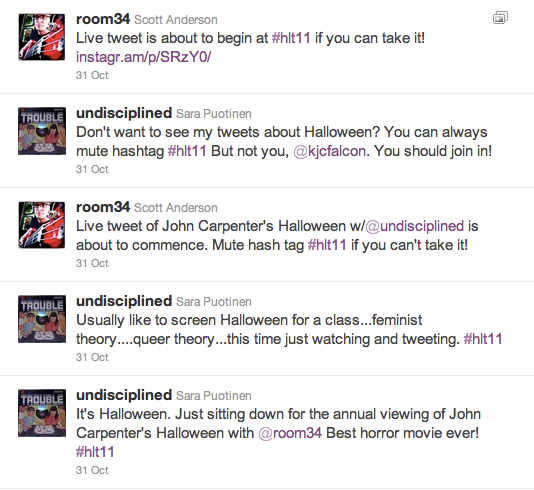My last post on live-tweeting Halloween inspired me to dig up my past notes on screening/teaching Halloween in my feminist and queer classes. In both classes, we discussed the film in relation to Carol Clover’s Men, Women and Chainsaws:
Day Eighteen (11.2.06)
Reactions to Halloween
- what is the story? Outline of plot
- listing of characters
- representations of women?
Introduction to Clover
- her background
- the notion of the final girl has been very significant
- What is the argument of the final girl?
Clover argues that the phenomenon of the final girl within late 1970s/early 80s slasher films is significant for rethinking how we understand gender within these films. In contrast to the traditional understanding of gender and the masculine gaze as sadistic and objectifying, Clover argues that within slasher films, male audience members identify with the final girl; they don’t objectify her or find pleasure in her suffering but root for her to vanquish the killer.
Who is the final girl?
Halloween = Laurie
- the one who doesn’t die/survivor
- encounters the mutilated bodies of her friends/understands the horror
- she is chased, cornered and wounded
- screams, staggers, falls, rises again
- looks death in the face
Clips:
Chapter 7: introduction to her as bookish, smart, different, asexual read parts from Clover essay (39) + boyish quotes as well
Chapter 22: her experience of the horror, confronts it. Clover 35, bottom 39)
Chapter 24: trapped in the closet, able to defend herself (35, bottom 39)
Elements of Clover’s argument:
- Basic argument = male gaze is not exclusively about objectifying women or about getting sadistic pleasure out of their pain/suffering/death [although that is evident in the film] A different type of girl, the final girl, exists
- Final girl complicates the classic gender division of male active/hero and female as passive/victim…The final girl represents both
- She is a masculine female: How is this represented in the film? Her name, her interests, her disinterest in boys, her intelligence, her heroism/ability to fight back (see 48)
- Gender fluidity: “The world of horror is in any case one that knows very well that men and women are profoundly different (and that the former are vastly superior to the latter) but one that at the same time repeatedly contemplates mutations and slidings where women begin to look a lot like men” (15)
- The audience may shift their identification throughout the early parts of the film, starting with the killer as a boy, but by the end of the film we fully identify with the final girl as hero (see 44-45). This challenges the idea that the gaze is always male and that the primary identification is with the man/male character-hero
- One sex versus two sex…arguing that horror films play with gender—Halberstam quote about queering gender (Butler too) “improperly or inadequately gendered bodies represent the limits of the human and they present a monstrous arrangement of skin, flesh, social mores, pleasures, dangers and wounds. The bodies that splatter in horror films are interestingly enough properly gendered ‘human’ bodies, female bodies, in fact with the conventional markings of their femininity. Female bodies that do not splatter, then, are often sutured bodies, bodies that are in some way distanced from the gender constructions that would otherwise sentence them to messy and certain death. Carol Clover has named the improperly gendered, de-girled being as the ‘final girl’ (141).
The point of her argument is not to suggest that horror films aren’t sadistic-voyeuristic, but that they are more complicated than that. Women are surely objectified in this movie and gender roles are reinforced, yet something else, something that complicates how we understand gender to function, is happening. The horror film demonstrates that gender is not rigid but fluid.
What do you think about her argument?
What are some other interpretations for what is going on here?
What struck you about the Clover article? The movie?
And here’s the worksheet I distributed when I screened it my queering theory class in 2009:
Queering Theory
29 October 2009
Halloween
IDENTIFICATION: The Gaze
Who is looking? How are they looking? What are they looking at?
Who is active? Passive?
How is the gaze gendered? Sexed? Is it always male? Always heterosexual?
Are there possibilities for looking at this queerly?
Primary Identification: from the perspective of the camera
Secondary Identification: with the character of empathetic choice
- Who are we meant to identify with in this film? (How) does our primary identification shift? What about our secondary identification? (See page 45)
- Why is this shifting identification significant for how we understand what is happening to sex/gender/desire, the subject/abject, the possibilities for queer looking?
- Is the gaze in a horror film, as Mulvey and many feminists suggest, sadistic-voyeuristic (Clover, 8)?
Voyeuristic looking involves a controlling gaze and Mulvey argues that this has associations with sadism: ‘pleasure lies in ascertaining guilt – asserting control and subjecting the guilty person through punishment or forgiveness’ (Mulvey 1992, 29).
What else does Clover think is going on when the audience (young heterosexual men) watch a movie like Halloween? Do they watch it because they like watching young women be tortured?
Key question for Clover: But if it is so that all of us, male and female alike, are by these processes “made to” identify with men and “against” women, how are we then to explain the appeal to a largely male audience of a film genre that features a female victim-hero (Clover, 44)?
REPETITION:
the free exchange of themes and motifs, the archetypal characters and situations, the accumulation of sequels, remakes, imitations. This is a field in which there is in some sense no original, no real or right text, but only variants…(Clover, 11). Do you see parallels with Butler here—her notion of gender performativity?
Why horror? its engagement of repressed fears and desires and its reenactment of the residual conflict surrounding those feelings (Clover, 11).
Sex/Gender: What is the gender of the victim? The monster? The Hero?
Sex, in this universe, proceeds from gender, not the other way around (Clover, 13).
What does she mean by this? How does it function in Halloween? Connections with queering theory?
- What are the differences between the single sex and the two-sex system? What understanding of sexual difference is being employed in Halloween—according to Clover? According to your viewing?
- How do sex and gender work in this film? Does gender directly follow from sex (body)? What sorts of slippages do you see?
- What types of visual/narrative/language cues about gender and desire do we get in the film? (e.g. Clover discusses how the masculinized final girl almost always has an ambiguous/manly name. See also her discussion on 39-40.)
What is the final girl? What is the significance of this concept for our viewing (and thinking about) horror films?
WHAT? The fact that horror film so stubbornly figures the killer as male and the principal as female would seem to suggest that representations itself is at issue—that the sensation of bodily fright derives not exclusively from repressed content, as Freud insisted, but also from the bodily manifestations of that content (Clover, 47).
What gender is the killer? (How) does their gender shift throughout the film?
What gender is the final girl (victim/hero)? How does their gender shift?
- What connections do you see between Butler’s articulations of the abject with the Michael Myers? How does the child psychologist—Dr Loomis—describe Michael?
- What connections can we draw between the figures of the killer and the final girl—are they different parts of the same person (Subject/abject?) See 49.
Abject terror as feminine: Abject terror is gendered feminine…form of crying, cowering, screaming, fainting, trembling, begging for mercy. Subject = male= forceful anger (Clover, 51).
Gender fluidity/uncertainty: not just the case that the thrill comes from fooling with gender and gender ambiguity (56)
Single sex or both sexes at once? Halloween is a test in which the categories masculine and feminine, traditionally embodied in male and female, are collapsed into one and the same character [Laurie]—a character who is anatomically female and one whose points of view the spectato if unambiguously invited, by the usual set of literary-structural cinematic conventions, to share (Clover, 61).
KEY QUESTION: Clover is analyzing the genre of slasher films primarily from a feminist perspective here. Her analysis of how gender functions within the genre (and films like Halloween) is about moving beyond the simple dismissal of slasher films as low brow fantasies of violent males and victimized females. In what ways does/can our analysis of this genre/Halloween change when we take a queer perspective? What is a queer perspective? In other words, how can we queer this?
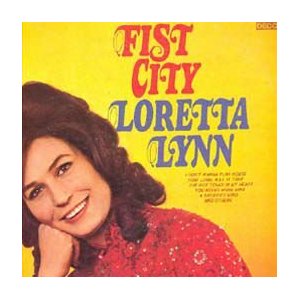 Last weekend, RJP, FWA and I were listening to a local radio station (the awesome The Current) when Loretta Lynn’s song, “Fist City” came on. Immediately it reminded me of Lurleen Lumpkin from The Simpsons (L Lynn must be the inspiration for this character). After listening to the lyrics I realized that Loretta Lynn is pretty awesome. Sure, I knew about her and had probably listened to some of her music when I was younger, but I don’t think I had ever heard this song or really thought about the lyrics and how they speak to/about a certain form of making (and being) in trouble. This form of making trouble has a lot to with class, particularly poor white folks living in the U.S. South in the 20th Century. There is some great feminist work that describes and theorizes about these experiences. Some of this work has been helpful in expanding, complicating and deepening my understandings of troublemaking and troublestaying. In particular, I’m thinking of Dorothy Allison and “The Question of Class,” Bastard Out of Carolina and Two or three things I know for sure and Mab Segrest and Memoir of a Race Traitor.
Last weekend, RJP, FWA and I were listening to a local radio station (the awesome The Current) when Loretta Lynn’s song, “Fist City” came on. Immediately it reminded me of Lurleen Lumpkin from The Simpsons (L Lynn must be the inspiration for this character). After listening to the lyrics I realized that Loretta Lynn is pretty awesome. Sure, I knew about her and had probably listened to some of her music when I was younger, but I don’t think I had ever heard this song or really thought about the lyrics and how they speak to/about a certain form of making (and being) in trouble. This form of making trouble has a lot to with class, particularly poor white folks living in the U.S. South in the 20th Century. There is some great feminist work that describes and theorizes about these experiences. Some of this work has been helpful in expanding, complicating and deepening my understandings of troublemaking and troublestaying. In particular, I’m thinking of Dorothy Allison and “The Question of Class,” Bastard Out of Carolina and Two or three things I know for sure and Mab Segrest and Memoir of a Race Traitor.

